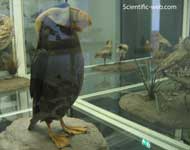The Tufted Puffin (Fratercula cirrhata) is a relatively abundant medium-sized pelagic seabird in the auk (Alcidae) family found throughout the North Pacific Ocean. It is one of three species of puffin that comprise the Fratercula genus and is easily recognizable by its thick red bill and yellow tufts. Taxonomy The Tufted Puffin was first described in 1769 by German zoologist Peter Simon Pallas. Its generic name is derived from the Latin Fratercula 'little brother' and the specific epithet, cirrhata 'tufted'.[1] Description They are mostly black with a white facial patch, and, typical of other puffin species, feature a very thick bill which is mostly red with some yellow and occasionally green markings. Their most distinctive feature and namesake are the yellow tufts (Latin: cirri) that appear annually on birds of both sexes as the summer reproductive season approaches. Their feet become bright red and their face also becomes bright white in the summer. During the feeding season, the tufts moult off and the plumage, beak and legs lose much of their lustre. As among other alcids, the wings are relatively short, adapted for diving, underwater swimming and capturing prey rather than gliding, of which they are incapable. As a consequence, they have thick, dark myoglobin-rich breast muscles adapted for a fast and aerobically strenuous wing-beat cadence, which they can nonetheless maintain for long periods of time. Juvenile puffins resemble winter adults, but with a grey-brown breast, white belly, and a shallow, brown bill.[2] Distribution and habitat Tufted Puffins form dense breeding colonies during the summer reproductive season from British Columbia, throughout southeastern Alaska and the Aleutian Islands, Kamchatka, the Kuril Islands and throughout the Sea of Okhotsk.[3] While they share some habitat with Horned Puffins (F. corniculata), the range of the Tufted Puffin is generally more southern. They once nested as far south as southern California, but now only a few scattered colonies remain off northern California.[2] Tufted Puffins typically select islands or cliffs that are relatively inaccessible to predators, close to productive waters, and high enough that they can take to the air successfully. Ideal habitat is steep but with a relatively soft soil substrate and grass for the creation of burrows.[4] During the winter feeding season, they spend their time almost exclusively at sea, extending their range throughout the North Pacific and south to Japan and California. Behaviour Breeding Breeding takes place on isolated islands: over 25,000 pairs have been recorded in a single colony off the coast of British Columbia. The nest is usually a simple burrow dug with the bill and feet, but sometimes a crevice between rocks is used instead. It is well-lined with vegetation and feathers. Courtship occurs through skypointing, strutting, and billing. A single egg is laid, usually in June, and incubated by both parents for about 45 days. Fledglings leave the nest at between 40 and 55 days. Diet Tufted Puffins feed almost exclusively on fish, which they catch by diving from the surface. Adults may also feed on squid or other invertebrates. Feeding areas can be located far offshore from the nesting areas. Puffins can store large quantities of small fish in their bills and carry them to their chicks. Predators and threats Tufted Puffins are preyed upon by various avian raptors such as Snowy Owls, Bald Eagles and Peregrine Falcons, and mammals like the Arctic Foxes. Foxes seem to prefer the puffin over other birds, making the bird a main target. Choosing inaccessible cliffs and entirely mammal-free islands protects them from terrestrial predators while laying eggs in burrows is effective in protecting them from egg-scavengers like gulls and ravens.[2] Puffins and man The Aleut and Ainu people of the North Pacific traditionally hunted Tufted Puffin for food and feathers. Skins were used to make tough parkas worn feather side in and the silky tufts were sewn into ornamental work. Currently, harvesting of Tufted Puffin is illegal or discouraged throughout its range.[4] Cited sources 1. ^ Simpson, D.P. (1979). Cassell's Latin Dictionary (5 ed.). London: Cassell Ltd.. pp. 883. ISBN 0-304-52257-0. Additional references * BirdLife International (2004). Fratercula cirrhata. 2006 IUCN Red List of Threatened Species. IUCN 2006. Retrieved on 11 May 2006. Database entry includes justification for why this species is of least concern External links
|
|

